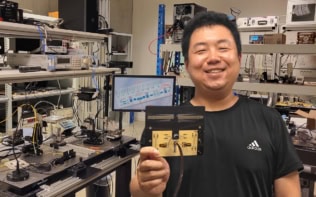Prediction is very difficult, said Niels Bohr, especially about the future. Two decades ago optical computing was a thriving area of research that offered the prospect of computers much faster than those available at the time. Of course, computers are indeed much faster today than they were 20 years ago, but they are still not optical. However, there have been more than enough developments in other areas of optics, both pure and applied, over this period to compensate for that particular disappointment. Some of these advances were planned or predicted, but many were completely unexpected.

Although computers have remained resolutely electronic, the growth of fibre-based optical communication between machines (and people) has been relentless. For a few years starting in the late 1990s this allowed the companies that produced the “picks and shovels of the Internet” – lasers, amplifiers and other optical components – to make huge sums of money, only to lose it again in the telecoms crash of 2002.
The semiconductor industry has become accustomed to such cycles, but the events of the past few years have been a baptism of fire for many companies producing optical components. However, many laser makers that had previously focused on telecoms applications are now beginning to diversify into other sectors. Those that produce fibre lasers, for instance, are moving into traditional heavy-laser applications such as welding and materials processing.
The use of semiconductor diode lasers for optical data storage has also grown to become a massive industry, driven by the rise of the DVD, and the global market for diode lasers is worth some $2bn. And last year sales of flat-panel displays – mainly liquid-crystal displays for computers and plasma screens for television sets – overtook those of that electron-based workhorse, the cathode-ray tube, for the first time.
Looking to the future, a new generation of solid-state lighting has the potential to replace traditional incandescent and fluorescent sources by offering improved energy efficiency, lower costs and greater versatility. Finally, the recent development of the first all-silicon laser capable of generating a continuous wave output represents a major breakthrough for the optoelectronics industry (see “Silicon chips light up”).
Fundamental research in optics is also thriving, continuing the revolution in quantum optics that Einstein started 100 years ago (see “Einstein’s revolutionary paper”). In this issue, for instance, you can read about new and surprising results in seemingly well-understood areas such as total internal reflection and the double-slit experiment (see “Young’s slits revisited”). Attosecond lasers, negative-index materials, bioimaging, and photonic crystals and fibres are other areas where progress is rapid.
Advice on pursuing a career in optics can be found on page 50. While it is impossible to predict what will happen next in either the academic or industrial world, it is sure to be interesting.



